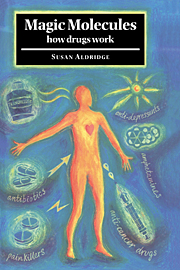Book contents
- Frontmatter
- Contents
- List of illustrations
- Acknowledgements
- Introduction
- 1 How drugs work
- 2 From penicillin to Prozac: introducing pharmaceutical drugs
- 3 Fighting infection
- 4 The hormonal revolution
- 5 Cardiovascular drugs: protecting the heart and brain
- 6 The problem of pain
- 7 The cancer challenge
- 8 Drugs for the mind
- 9 Drugs of recreation and addiction
- 10 Natural alternatives: vitamins, minerals and herbs
- 11 In the pipeline: gene-based medicine
- Bibliography
- Index
9 - Drugs of recreation and addiction
Published online by Cambridge University Press: 05 August 2012
- Frontmatter
- Contents
- List of illustrations
- Acknowledgements
- Introduction
- 1 How drugs work
- 2 From penicillin to Prozac: introducing pharmaceutical drugs
- 3 Fighting infection
- 4 The hormonal revolution
- 5 Cardiovascular drugs: protecting the heart and brain
- 6 The problem of pain
- 7 The cancer challenge
- 8 Drugs for the mind
- 9 Drugs of recreation and addiction
- 10 Natural alternatives: vitamins, minerals and herbs
- 11 In the pipeline: gene-based medicine
- Bibliography
- Index
Summary
All the drugs we have considered so far are generally prescribed for medicinal purposes, and are used in a controlled way. Now we move on, to look at all those other drugs which we consume for pleasure. The use of such drugs is part of human experience around the world and is deeply rooted in our culture and history – although patterns of consumption and degrees of social and legal acceptability vary widely from drug to drug.
Most people take the caffeine in a mid-morning coffee, or the alcohol in a bottle of Sauvignon Blanc shared over dinner, for granted. What is more, there is no social stigma attached to the consumption of caffeine and the moderate use of alcohol. However, although the consumption of cannabis, Ecstasy, and cocaine is almost as widespread in some sections of society their users – if they are wise – are more discreet because of the legal restrictions surrounding these drugs. And heroin consumers are almost universally pitied because it is assumed they must have an addiction problem. Meanwhile, smokers incur increasing social disapproval with more and more restrictions being put upon public consumption of tobacco.
The legal and social restrictions on recreational drugs have a complex relationship with the pharmacological properties of each substance. Each of the drugs – even, arguably, caffeine – is habit-forming to a greater or lesser extent and therefore has the potential for inflicting harm on the individual user and on society at large. And as with prescription medicines, recreational drugs have a number of side effects. However, social, political and economic factors weigh heavily against scientific factors when it comes to formulating drug legislation.
- Type
- Chapter
- Information
- Magic MoleculesHow Drugs Work, pp. 203 - 226Publisher: Cambridge University PressPrint publication year: 1998



